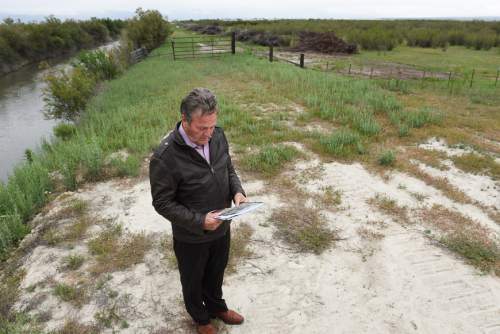This is an archived article that was published on sltrib.com in 2016, and information in the article may be outdated. It is provided only for personal research purposes and may not be reprinted.
In summer, millions of mosquitoes swarm the land the state has chosen for a new prison, and unless something changes, Salt Lake City homeowners will pay for the pesticides needed to reduce the blood suckers to a tolerable level.
That doesn't sit well with Ary Faraji, manager of the Salt Lake City Mosquito Abatement District, who estimates it would take more than $160,000 a year to fight the bugs around a new prison west of Salt Lake City International Airport. He delivered a presentation Tuesday before a group of state employees working on the prison project and interested residents during which he argued the Legislature should cover the ongoing cost.
"It really is unfair for the residents of Salt Lake City to take on that burden," he said.
Faraji plans to continue to raise the issue in coming sessions as the Legislature creates the budget for the project, which could top $550 million.
He estimates it would take 60 additional ground sprays and 16 passes with a specially equipped airplane to knock down the mosquitoes in the area to the level seen around the airport. Those planes shoot billions of microdrops of pesticide that actually hit the bugs as they fly, poisoning them.
His estimate considers only the cost from Salt Lake City, but the potential prison land abuts the Magna Mosquito Abatement District, which expects to incur an additional $50,000 to $80,000 in costs each year as it sprays pesticides.
The area is so rich in mosquitoes, along with other biting bugs such as deer flies and no-see-ums, because of the wetlands that border the Great Salt Lake. The spraying would reduce mosquitoes in an area as wide as 10 to 15 miles, Faraji said, likely encompassing duck clubs and a migratory-bird refuge.
Faraji doubts reducing the mosquito population would have much effect on the birds. The pesticide won't harm them, and birds tend to feast on bigger bugs than mosquitoes.
A more serious concern, he said, would be how prison construction modifies the habitat, spawning runoff from buildings and new pools of standing water.
Beyond the environmental concerns, Faraji is unsure how his employees would access the 500-acre prison site, or how the Department of Corrections would respond to the abatement district's planes flying over the prison at night.
Corrections spokeswoman Brooke Adams, who attended the meeting, said: "We definitely want to be part of a discussion in the future about the control of mosquitoes and other insects."
Mosquito control is just one of the challenges facing the new prison site. The state also has funded a study to see whether the dust blown from the dry lake bed contains contaminants.
Still, officials hope to pinpoint the final site west of the airport by summer's end and start construction next year with an eye toward completing a new prison in July 2020.





